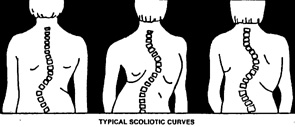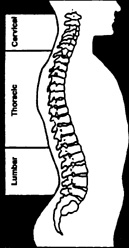|
|
|

|
What is Scoliosis? |
Scoliosis is a three-dimensional curvature of the spine. Normally, the spine curves backward in the chest and forward in the waist area when looking at a person from the side. From the back view, the spine should be straight, but in scoliosis the spine deviates toward one side or the other at different levels.

Scoliosis is not a disease, but rather a condition that may appear in more than one member of a family in the same or different generations. It does not develop as a result of anything that a child or his or her parents did or failed to do. It is a spinal disorder that usually appears during the early teen years, although it may appear in younger children as well.
Are there different types of scoliosis?
There are many causes for the development of scoliosis. About 89-90%
of the patients have a type known as idiopathic scoliosis. This means that
the exact cause of the curvature is unknown. It has been shown that idiopathic
scoliosis often runs in families and appears to be genetic in nature. It
is not known what "triggers" the development of the curve, or why some
curves progress more than others. Scoliosis occurs in otherwise perfectly
healthy children. Because scoliosis may appear at anytime during the growing
years, it is essential that the spine be checked regularly by the primary
care physician until growth is complete. The curvature may progress considerably
during the rapid teen-age growth spurt.
Scoliosis can also be caused by nerve and muscular disorders, such as polio. It can also be caused by congenital abnormalities in the formation of the vertebrae. It is important that the development of scoliosis in a particular patient be diagnosed to aid in the proper treatment.
 How
is it noticed?
How
is it noticed?
One of the most common signs of scoliosis is a prominent shoulder blade, frequently
the right one. One shoulder may also be higher and the child tends to "list"
to one side. The hips may be uneven and one seems to be higher than the other.
Scoliosis should not be confused with poor posture. Very often the first indication
of scoliosis is that there is something wrong with the fitting clothes. This
is very apparent in girls when observing the hem-line of a skirt or dress. When
a child with scoliosis bends forward, the appearance of a rib prominence is
one of the most striking signs.
Simple home test
Scoliosis, in its early years produces no pain and may be difficult to detect.
It may be present for several years in a form so mild that even a doctor might
very well fail to recognize it.
Adult scoliosis
In adults where scoliosis is mild, the condition may remain unchanged
or progress so slightly over the years that no serious problems may develop.
However, in some people, significant problems can occur. These include
back pain, increasing deformity caused by progression of the curve, and
the limitation of activities. In the most severe cases left untreated over
decades, breathing can also be a problem. Osteoporosis (thinning of the
bone), or osteo-malacia (softening of the bone) later in life can cause
a mild curvature to increase significantly. Degenerative conditions of
the discs and joints of the back may also cause a degenerative type of
scoliosis.
Can scoliosis be cured?
There are currently no medications to treat scoliosis, nor can the
onset be prevented. In most cases, when the curvature is recognized early
in its development, curve progression can be diminished with treatment.
When a significant scoliosis is detected, the Doctor may refer the patient
to an orthopedic spine specialist for evaluation and/or treatment.
Is scoliosis very common?
According to the Scoliosis Research Society working with the American
Academy of Orthopedic Surgeons, about 10% of the adolescent population
had some degree of scoliosis. This means that about 1,000,000 children
in the United States alone have scoliosis. Approximately one quarter of
these, or 2.2% will require medical attention which may consist of observation
for future progression of the curve, bracing, or surgery, depending upon
the degree of the curvature at the time of its detection. Some scoliosis
may be so mild that treatment may never be required.